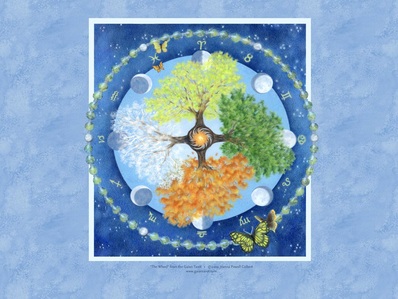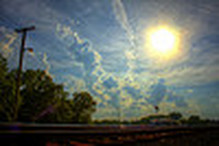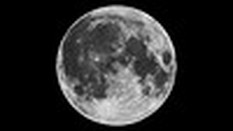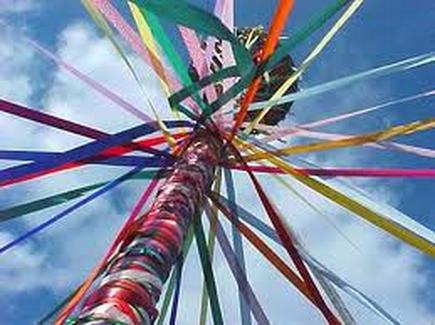The Wheel of the Year

- YULE
- IMBOLG
- OSTARA
- BELTANE
- MIDSUMMER
- LAMMAS
- MABON
- SAMHAIN
In Wicca we attune to the cycle of the earth through the celebration of her seasons. The festivals which are also called Sabbats, are celebrated at eight turning points throughout the year. This cycle of eight festivals is known to Wiccans as the Wheel of the year.
The wheel of the Year is so called for a good reason- wheels turn and return to the same point, but never quite the same place, and the wheel of nature continues to turn, to each season containing many new wonders.
Observation and celebration of these seasons will help you to become more attuned to the energies of Nature each year, it is a process that never stops.
No one person can ever be an expert on the nature of Nature.
SOLAR TIMING

The movement of the sun through the heavens is reflected both in our daily and annual lives. The sun rises from the dawn (sunrise) to the midpoint of the day when the sun is at it's zenith, and this is the time for solar work seeking to increase qualities associated with the Sun. Likewise from the midpoint to Sunset would be a time for getting rid of the negative solar qualities or working to transform them into positive ones.
LUNAR TIMING

The use of the phases of the moon is of major consideration in Wicca.
The New Moon is the time for performing magick for beginning new projects.
The Waxing Moon is a time for things you want to grow and increase,or attract to you.
The Full Moon is a time of fruition and completion.
The waining moon is a time for getting rid of things you want to lose, which also includes healing when you are getting rid of illness.
The Dark moon is a time of transformation, of moving between phases.
To this we may also add the significant time of the Half Moon- when the face of the Moon shows equal light and dark. This is a very good time for balancing work. You can do work that needs to balance lighter qualities on the waxing Half Moon, and work that concentrates on balancing darker qualities (including the unconscious) on the waining Half Moon.
The New Moon is the time for performing magick for beginning new projects.
The Waxing Moon is a time for things you want to grow and increase,or attract to you.
The Full Moon is a time of fruition and completion.
The waining moon is a time for getting rid of things you want to lose, which also includes healing when you are getting rid of illness.
The Dark moon is a time of transformation, of moving between phases.
To this we may also add the significant time of the Half Moon- when the face of the Moon shows equal light and dark. This is a very good time for balancing work. You can do work that needs to balance lighter qualities on the waxing Half Moon, and work that concentrates on balancing darker qualities (including the unconscious) on the waining Half Moon.
2011 Mercury Retrograde Dates:
Mer R Mar 30 2011 12:48 24°Ar21' R
Mer D Apr 23 2011 02:05 12°Ar54' D
Mer R Aug 2 2011 19:51 01°Vi12' R
Mer D Aug 26 2011 14:04 18°Le42' D
Mer R Nov 23 2011 23:20 20°Sg06' R
Mer D Dec 13 2011 17:43 03°Sg52' D Mer R- goes retrogradeMer D- goes direct
Mer R Mar 30 2011 12:48 24°Ar21' R
Mer D Apr 23 2011 02:05 12°Ar54' D
Mer R Aug 2 2011 19:51 01°Vi12' R
Mer D Aug 26 2011 14:04 18°Le42' D
Mer R Nov 23 2011 23:20 20°Sg06' R
Mer D Dec 13 2011 17:43 03°Sg52' D Mer R- goes retrogradeMer D- goes direct
The May Pole

One custom which has never died out is that of the May Pole. In the days of the old ways, the May Pole was made from the communal pine tree which had been decorated at Yule, with all of its uppermost branches now removed. The ribbons attached to its top are traditionally white and red, white for the virgin Goddess and red for the Mother. the May pole is a phallic symbol impregnating the birth canal being woven around it by the dancers. There are two thoughts on the symbology for the white and red streamers. One is that the red stands for the Sun God and the white for the Virgin Goddess. The men, holding the red streamers, and the women the white, weave the birth canal together, representing the union of the Goddess and God. The other is that the white, held by the women stands for the Virgin Goddess and the red, held by the men, stands for the mother aspect. Together the men help the virgin aspect meld herself into motherhood on the phallic pole.
The dancers then do a Morris dance, the Anglo name for May day dances, which are rich with pagan symbolism. It is not difficult, even in modern North America to find such a celebration going on at May Day.
Goats and Rabbits were sacred to the Beltane sabbat both because of the goats horns which symbolized the Horned God, and for their reputed randiness. Goats (sacred to the God) and rabbits (sacred to the Goddess) were prolific breeders who could be relied upon year after year to provide food and clothing.
The goat also provided milk, cheese, and butter, and dairy products figure heavily in the Beltane feast. Sweets were also an important part of the feasting. To combine the two elements, a rich dairy cream pie was baked for the celebrants.
*Recipe for Beltane cream pie may be found in the recipe section.
The dancers then do a Morris dance, the Anglo name for May day dances, which are rich with pagan symbolism. It is not difficult, even in modern North America to find such a celebration going on at May Day.
Goats and Rabbits were sacred to the Beltane sabbat both because of the goats horns which symbolized the Horned God, and for their reputed randiness. Goats (sacred to the God) and rabbits (sacred to the Goddess) were prolific breeders who could be relied upon year after year to provide food and clothing.
The goat also provided milk, cheese, and butter, and dairy products figure heavily in the Beltane feast. Sweets were also an important part of the feasting. To combine the two elements, a rich dairy cream pie was baked for the celebrants.
*Recipe for Beltane cream pie may be found in the recipe section.
THE SABBATS
cunningham
The Sabbats tell us one of the stories of the Goddess and God, of their relationship and the effects this has on the fruitfulness of the Earth. There are many variations on these myths, but here's a fairly common one, woven into the basic descriptions of the Sabbats.
YULE
The Goddess gives birth to a son, the God, at Yule (circa December 21). This is in no way an adaptation of Christianity. The Winter Solstice has long been viewed as a time of divine births. Mithras was said to have been born at this time. The Christians simply adopted it for their use in 273 C.E. (Common Era). Yule is a time of the greatest darkness and isthe shortest day of the year. Earlier peoples noticed such phenomena and supplicated the forces of nature to lengthen the days and shorten the nights. Witches sometimes celebrate Yule just before dawn, then watch the Sun rise as a fitting finale to their efforts. Since the God is also the Sun, this marks the point of the year when the Sun is reborn as well. Thus, the Witches light fires or candles to welcome the Sun's returning light. The Goddess, slumbering through the Winter of Her labor, rests after Her delivery. Yule is remnant of early rituals celebrated to hurry the end of Winter and the bounty of Spring, when food was once again readily available. To contemporary Witches it is a reminder that the ultimate product of death is rebirth, a comforting thought in these days of unrest.
IMBOLC
Imbolc (February 2) marks the recovery of the Goddess after giving birth to the God. The lengthening periods of light awaken Her. The God is a young, lusty boy, but His power is felt in the longer days. The warmth fertilizes the Earth (the Goddess), and causes seeds to germinate and sprout. And so the earliest beginnings of Spring occur. This is a Sabbat of purification after the shut-in life of Winter, through the renewing power of the Sun. It is also a festival of light and of fertility, once marked in Europe with huge blazes, torches and fire in every form. Fire here represents our own illumination and inspiration as much as light and warmth. Imbolc is also known as Feast of Torches, Oimelc, Lupercalia, Feast of Pan, Snowdrop Festival, Feast of the Waxing Light, Brighid's Day, and probably by many other names. Some female Witches follow the old Scandinavian custom of wearing crowns of lit candles, but many more carry tapers during their invocations. This is one of the traditional times for initiations into covens, and so self-dedication rituals, such as the one outlined in this Book of Shadows, can be performed or renewed at this time.
OSTARA
Ostara (circa March 21), the Spring Equinox, also known as Spring, Rites of Spring and Eostra's Day, marks the first day of true Spring. The energies of Nature subtly shift from the sluggishness of Winter to the exuberant expansion of Spring. The Goddess blankets the Earth with fertility, bursting forth from Her sleep, as the God stretches and grows to maturity. He walks the greening fields and delights in the abundance of nature. On Ostara the hours of day and night are equal. Light is overtaking darkness; the Goddess and God impel the wild creatures of the Earth to reproduce. This is a time of beginnings, of action, of planting spells for future gains, and of tending the ritual gardens.
BELTANE
Beltane (April 30) marks the emergence of the young God into manhood. Stirred by the energies at work in Nature, He desires the Goddess. They fall in love, lie among the grasses and blossoms, and unite. The Goddess becomes pregnant of the God. Witches celebrate the symbol of Her fertility in ritual. Beltane (also known as MayDay) has long been marked with feasts and rituals. May poles, supremely phallic symbols, were the focal point of Old English village rituals. Many persons rose at dawn to gather flowers and green branches from the fields and gardens, using them to decorate the May pole, their homes and themselves. The flowers and greenery symbolize the Goddess; the May pole the God. Beltane marks the return of vitality, of passion and hopes consummated. May poles are sometimes used by Witches today during Beltane rituals, but the cauldron is a more common focal point of ceremony. It represents, of course, the Goddess - the essence of womanhood, the end of all desire, the equal but opposite of the May pole, symbolic of the God.
MIDSUMMER
Midsummer, the SummerSolstice (circa June 21), also known as Litha, arrives when the powers of Nature reach their highest point. The Earth is awash in the fertility of the Goddess and God. In the past, bonfires were leapt to encourage fertility, purification, health and love. The fire once again represents the Sun, feted on this time of the longest daylight hours. Midsummer is a classic time for magick of all kinds.
LUGHNASADH
Lughnasadh (August 1)is the time of the first harvest, when the plants of Spring wither and drop their fruits or seeds for our use as well as to ensure future crops. Mystically, so too does the God lose His strength as the Sun rises farther in the South each day and the nights grow longer. The Goddess watches in sorrow and joy as She realizes that the God is dying, and yet lives on inside Her as Her child. Lughnasadh, also known as August Eve, Feast of Bread, Harvest Home and Lammas, wasn't necessarily observed on this day. It originally coincided with the first reapings. As Summer passes, as we remember its warmth and bounty in the food we eat. Every meal is an act of atunement with Nature, and we are reminded that nothing in the universe is constant.
MABON
Mabon (circaSeptember 21), theAutumn Equinox,is the completion of the harvest begun as Lughnasadh. Once again day and night are equal, poised as the God prepares to leave His physical body and begin the great adventure into the unseen, toward renewal and rebirth of the Goddess. Nature declines, drawsback its bounty, readying for Winterand its time of rest. The Goddess nods in the weakening Sun, though fire burns within Her womb. She feels the presence of the God even as He wanes.
SAMHAIN
At Samhain (October 31), the Craft say farewell to the God. This is a temporary farewell. He isn't wrapped in eternal darkness, but readies to be reborn of the Goddess at Yule. Samhain, also known as November Eve, Feast of the Dead, Feast of Apples, Hallows, All Hallows and Hallowe'en, once marked the time of sacrifice. In some places this was the time when animals were slaughtered to ensure food throughout the depths of Winter. The God - identified with the animals - fell as well to ensure our continuing existence. Samhain is a time of reflection, of looking back over the last year, of coming to terms with the one phenomenon of life over which we have no control - death. The Craft feel that on this night the separation between the physical and spiritual realities is thin. We remember our ancestors and all those who have gone before.
After Samhain, We celebrate Yule, and so the Wheel of the Year is complete.
